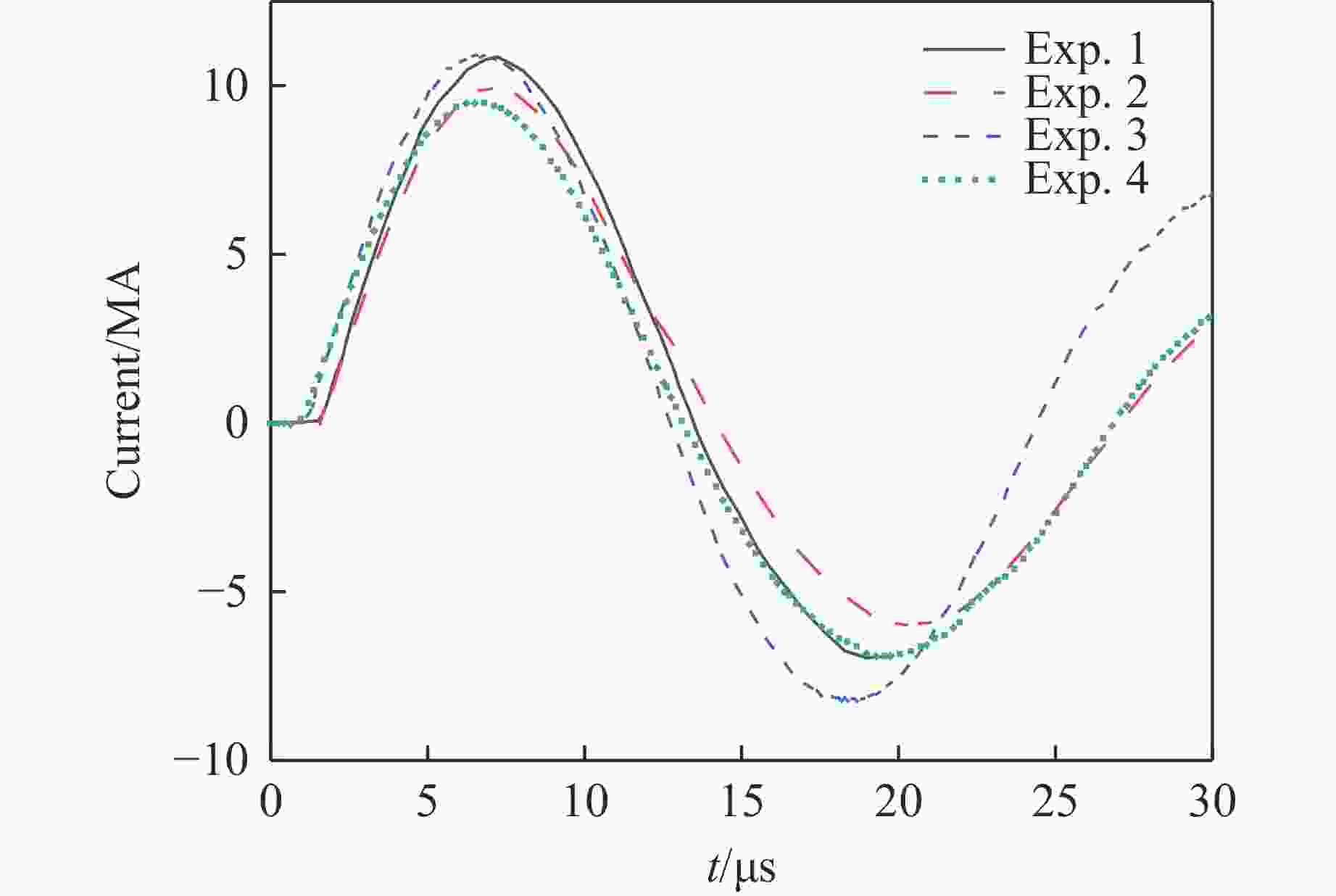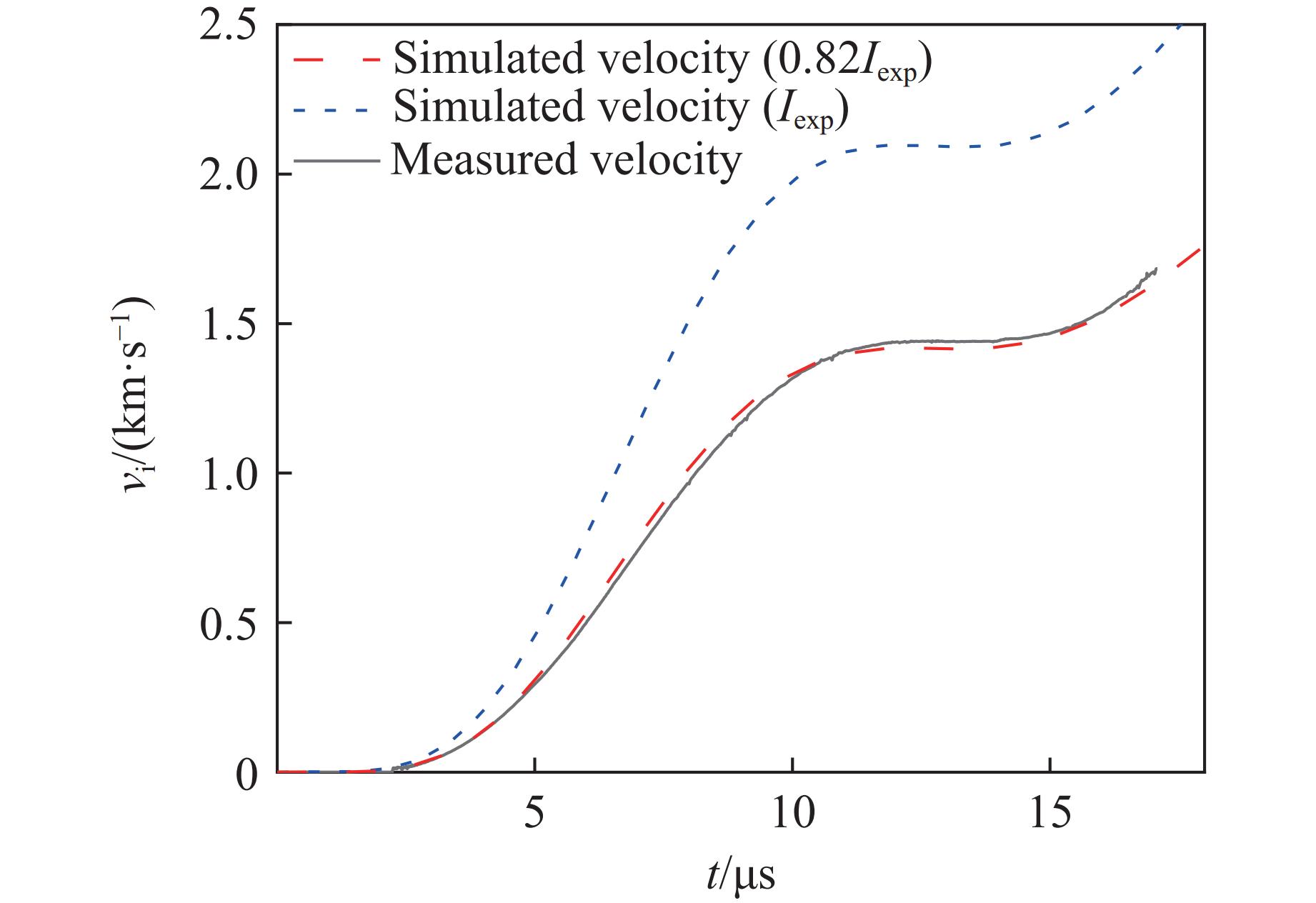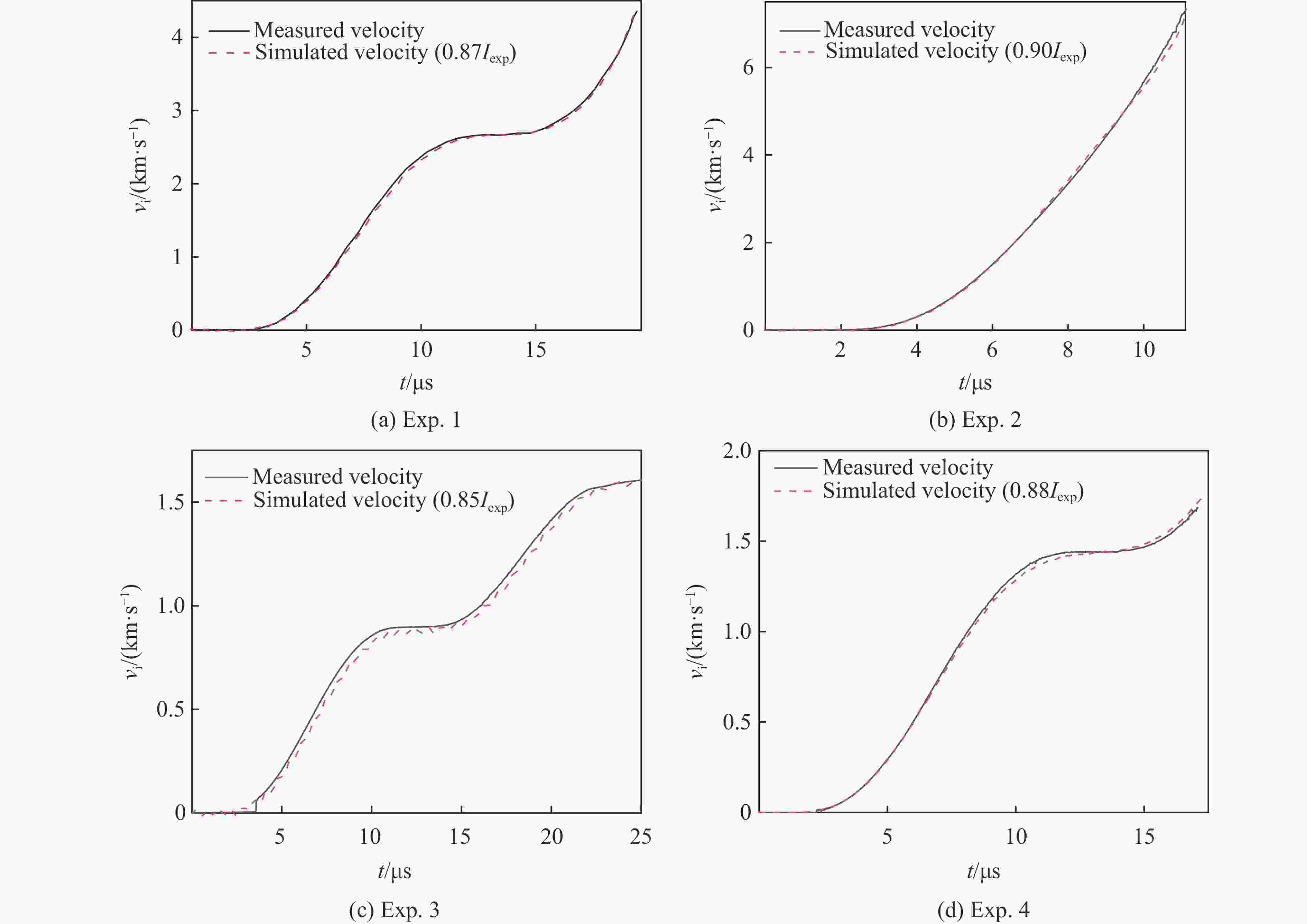Current Coefficient Law in Simulation of Magnetically Driven Solid Liner Experiment
-
摘要: 采用不可压缩理论模型,对FP-2装置上开展的磁驱动固体套筒实验进行了模拟分析。模拟结果表明,无论是二维磁流体力学理论模型,还是其他不可压缩理论模型,回流罩结构磁驱动固体套筒的边界磁感应强度公式中都包含一个小于1的套筒电流系数。对不同套筒厚度、不同套筒半径条件下磁驱动固体套筒实验的电流系数进行了模拟,发现电流系数不仅与套筒内半径有关,还与套筒厚度有关;套筒内半径越大,套筒电流系数越小;套筒厚度越大,套筒电流系数越小。准确掌握磁驱动固体套筒电流系数的变化规律,可使磁流体程序从磁驱动固体套筒实验的后验模拟发展为精确预测,使磁流体力学模型真正具备正确设计和指导磁驱动固体套筒相关实验的理论能力。
-
关键词:
- 磁驱动固体套筒实验 /
- 二维磁驱动数值模拟程序 /
- 磁流体力学 /
- 电流系数 /
- 回流罩结构
Abstract: The magnetically driven solid liner experiments on the FP-2 device were simulated and analyzed based on the incompressible theoretical model. The simulation results show that the boundary magnetic induction strength formula for the magnetically driven solid liner of the reflux hood structure contains a liner current coefficient of less than 1, regardless of whether it is a two-dimensional magnetohydrodynamic (MHD) theoretical model or other incompressibility theoretical models. The current coefficient law of the magnetically driven solid liner experiment on the FP-2 was studied by simulating the magnetically driven solid liner experiment with different thickness and radii. The current coefficient of magnetically driven solid liner experiment is not only related to the liner’s inner radius, but also to the liner’s thickness. The larger the inner radius of the liner, the smaller the current coefficient, and the larger the thickness of the liner, the smaller the current coefficient. Exploring the current coefficient law in magnetically driven solid liner experiment with reflux hood structure can make the MHD code develop from post-simulation to accurate prediction. And the MHD theoretical model can be employed to design correctly and guide the related experiments of magnetically driven solid liner with a reflux hood structure. -
表 1 磁驱动固体套筒实验的套筒参数
Table 1. Liner parameters of the magnetically driven solid liner experiments
Exp. No. Liner material Liner’s inner radius/mm Liner’s thickness/mm 1 Al 45 0.6 2 Al 30 0.6 3 Al 45 1.6 4 Al 30 1.9 表 2 磁驱动固体套筒实验的电流系数
Table 2. Current coefficients of the magnetically driven solid liner experiments
Exp. No. Liner’s inner radius/mm Liner’s thickness/mm fc 1 45 0.6 0.87 2 30 0.6 0.90 3 45 1.6 0.85 4 30 1.9 0.88 -
[1] TURCHI P J, BAKER W L. Generation of high-energy plasmas by electromagnetic implosion [J]. Journal of Applied Physics, 1973, 44(11): 4936–4945. doi: 10.1063/1.1662066 [2] MARTIN M R, LEMKE R W, MCBRIDE R D, et al. Solid liner implosions on Z for producing multi-megabar, shockless compressions [J]. Physics of Plasmas, 2012, 19(5): 056310. doi: 10.1063/1.3694519 [3] BUYKO A M, ZMUSHKO V V, ATCHISION W L, et al. Results and prospects of material strength studies on electrophysical facilities based on perturbation growth in liner systems [J]. IEEE Transactions on Plasma Science, 2008, 36(1): 104–111. doi: 10.1109/TPS.2007.914072 [4] KAUL A M, IVANOVSKY A V, ATCHISON W L, et al. Damage growth and recollection in aluminum under axisymmetric convergence using a helical flux compression generator [J]. Journal of Applied Physics, 2014, 115(2): 023516. doi: 10.1063/1.4861411 [5] REINOVSKY R E, ANDERSON W E, ATCHISO W L, et al. Instability growth in magnetically imploded high-conductivity cylindrical liners with material strength [J]. IEEE Transactions on Plasma Science, 2002, 30(5): 1764–1776. doi: 10.1109/TPS.2002.805418 [6] REINOVSKY R E, ATCHISO W L, DIMONTE G, et al. Pulsed-power hydrodynamics: an application of pulsed-power and high magnetic fields to the exploration of material properties and problems in experimental hydrodynamics [J]. IEEE Transactions on Plasma Science, 2008, 36(1): 112–124. doi: 10.1109/TPS.2007.914708 [7] ZHANG S L, LIU W, WANG G L, et al. Investigation of convergent Richtmyer-Meshkov instability at tin/xenon interface with pulsed magnetic driven imploding [J]. Chinese Physics B, 2019, 28(4): 044702. doi: 10.1088/1674-1056/28/4/044702 [8] RYUTOV D D, DERZON M S, MATZEN M K. The physics of fast Z pinches [J]. Reviews of Modern Physics, 2000, 72(1): 167–223. doi: 10.1103/RevModPhys.72.167 [9] 丁宁, 杨震华, 宁成. Z箍缩等离子体内爆实验金属丝阵负载优化设计分析 [J]. 物理学报, 2004, 53(3): 808–817. doi: 10.7498/aps.53.808DING N, YANG Z H, NING C. Optimization design of a wire array load for Z-pinch plasma implosion experiments [J]. Acta Physica Sinica, 2004, 53(3): 808–817. doi: 10.7498/aps.53.808 [10] 丁宁, 张扬, 宁成, 等. PTS装置Z箍缩负载设计分析 [J]. 物理学报, 2008, 57(5): 3027–3037. doi: 10.7498/aps.57.3027DING N, ZHANG Y, NING C, et al. Design and analysis of the Z-pinch loads on the PTS facility [J]. Acta Physica Sinica, 2008, 57(5): 3027–3037. doi: 10.7498/aps.57.3027 [11] 章征伟, 魏懿, 孙奇志, 等. 材料强度对电磁驱动固体套筒内爆过程的影响 [J]. 强激光与粒子束, 2016, 28(4): 045017. doi: 10.11884/HPLPB201628.125017ZHANG Z W, WEI Y, SUN Q Z, et al. Effect of material strength on electromagnetic driven solid liner implosion [J]. High Power Laser and Particle Beams, 2016, 28(4): 045017. doi: 10.11884/HPLPB201628.125017 [12] 张绍龙, 章征伟, 孙奇志, 等. 电流脉冲前沿对电磁驱动固体套筒内爆的影响 [J]. 强激光与粒子束, 2017, 29(10): 105002. doi: 10.11884/HPLPB201729.170161ZHANG S L, ZHANG Z W, SUN Q Z, et al. Effect of current rise time on electromagnetic driven solid liner implosion [J]. High Power Laser and Particle Beams, 2017, 29(10): 105002. doi: 10.11884/HPLPB201729.170161 [13] 章征伟, 王贵林, 张绍龙, 等. 电作用量在磁驱动固体套筒内爆设计分析中的应用 [J]. 物理学报, 2020, 69(5): 050701. doi: 10.7498/aps.69.20191690ZHANG Z W, WANG G L, ZHANG S L, et al. Application of electrical action to design and analysis of magnetically driven solid liner implosion [J]. Acta Physica Sinica, 2020, 69(5): 050701. doi: 10.7498/aps.69.20191690 [14] TUCKER T J, TOTH R P. EBW1: a computer code for the prediction of the behavior of electrical circuits containing exploding wire elements: SAND-75-0041 [R]. Albuquerque: Sandia National Laboratory, 1975. [15] 章征伟. 磁驱动固体套筒内爆理论与实验研究 [D]. 绵阳: 中国工程物理研究院, 2020: 49−59.ZHANG Z W. Theoretic and experimental study on magnetically driven solid liner implosion [D]. Mianyang: China Academy of Engineering Physics, 2020: 49−59. [16] 张扬, 戴自换, 孙奇志, 等. FP-1装置铝套筒内爆动力学过程的一维磁流体力学模拟 [J]. 物理学报, 2018, 67(8): 080701. doi: 10.7498/aps.67.20172300ZHANG Y, DAI Z H, SUN Q Z, et al. One-dimensional magneto-hydrodynamics simulation of magnetically driven solid liner implosions on FP-1 facility [J]. Acta Physica Sinica, 2018, 67(8): 080701. doi: 10.7498/aps.67.20172300 [17] 阚明先, 贾月松, 张南川, 等. 回流罩结构Z-箍缩实验的数值模拟 [J]. 强激光与粒子束, 2023, 35(2): 025003. doi: 10.11884/HPLPB202335.220271KAN M X, JIA Y S, ZHANG N C, et al. Simulation of Z-pinch experiments with a reflux hood structure [J]. High Power Laser and Particle Beams, 2023, 35(2): 025003. doi: 10.11884/HPLPB202335.220271 [18] ROUSCULP C L, ORO D M, GRIEGO J R, et al. Investigation of surface phenomena in shocked tin in converging geometry: LA-UR-16-21901 [R]. Los Alamos: Los Alamos National Laboratory, 2016. [19] SUN Q Z, JIA Y S, ZHANG Z W, et al. Cylindrical metal liner implosion at extremes of pressure and material velocity on an intense pulsed power facility-FP-2 [J]. Review of Scientific Instruments, 2022, 93(1): 013904. doi: 10.1063/5.0064238 [20] 阚明先, 王刚华, 赵海龙, 等. 磁驱动飞片二维磁流体力学数值模拟 [J]. 强激光与离子束, 2013, 25(8): 2137–2141. doi: 10.3788/HPLPB20132508.2137KAN M X, WANG G H, ZHAO H L, et al. Two-dimensional magneto-hydrodynamic simulations of magnetically accelerated flyer plates [J]. High Power Laser and Particle Beams, 2013, 25(8): 2137–2141. doi: 10.3788/HPLPB20132508.2137 [21] 阚明先, 蒋吉昊, 王刚华, 等. 衬套内爆ALE方法二维MHD数值模拟 [J]. 四川大学学报(自然科学版), 2007, 44(1): 91–96. doi: 10.3969/j.issn.0490-6756.2007.01.020KAN M X, JIANG J H, WANG G H, et al. ALE simulation of 2D MHD for liner [J]. Journal of Sichuan University (Natural Science Edition), 2007, 44(1): 91–96. doi: 10.3969/j.issn.0490-6756.2007.01.020 [22] KAN M X, ZHANG Z H, XIAO B, et al. Simulation of magnetically driven flyer plate experiments with an improved magnetic field boundary formula [J]. High Energy Density Physics, 2018, 26: 38–43. doi: 10.1016/j.hedp.2017.12.002 [23] 阚明先, 段书超, 王刚华, 等. 自由面被烧蚀磁驱动飞片的数值模拟 [J]. 强激光与粒子束, 2017, 29(4): 045003. doi: 10.11884/HPLPB201729.160482KAN M X, DUAN S C, WANG G H, et al. Numerical simulation of magnetically driven flyer plate of ablated free surface [J]. High Power Laser and Particle Beams, 2017, 29(4): 045003. doi: 10.11884/HPLPB201729.160482 [24] 阚明先, 段书超, 王刚华, 等. 磁驱动飞片发射实验结构系数初步研究 [J]. 强激光与粒子束, 2020, 32(8): 085002. doi: 10.11884/HPLPB202032.200072KAN M X, DUAN S C, WANG G H, et al. Structure coefficient in magnetically driven flyer plate experiment [J]. High Power Laser and Particle Beams, 2020, 32(8): 085002. doi: 10.11884/HPLPB202032.200072 [25] 阚明先, 刘利新, 南小龙, 等. 磁驱动样品实验数值模拟研究 [J]. 高压物理学报, 2023, 37(6): 062301. doi: 10.11858/gywlxb.20230683KAN M X, LIU L X, NAN X L, et al. Numerical simulation of magnetically driven sample experiment [J]. Chinese Journal of High Pressure Physics, 2023, 37(6): 062301. doi: 10.11858/gywlxb.20230683 [26] 阚明先, 段书超, 张朝辉, 等. 二维磁驱动数值模拟程序MDSC2的验证与确认 [J]. 强激光与粒子束, 2019, 31(6): 065001. doi: 10.11884/HPLPB201931.180300KAN M X, DUAN S C, ZHANG Z H, et al. Verification and validation of two dimensional magnetically driven simulation code MDSC2 [J]. High Power Laser and Particle Beams, 2019, 31(6): 065001. doi: 10.11884/HPLPB201931.180300 -







 下载:
下载:





